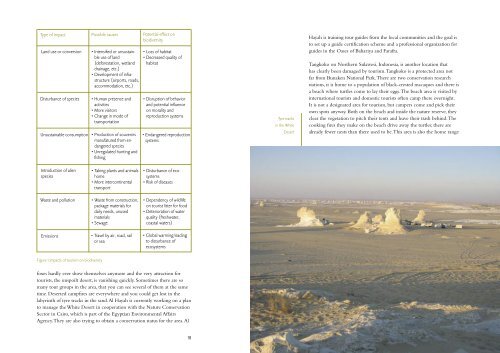OMSLAG 5.indd - IUCN
OMSLAG 5.indd - IUCN
OMSLAG 5.indd - IUCN
Create successful ePaper yourself
Turn your PDF publications into a flip-book with our unique Google optimized e-Paper software.
Type of impact Possible causes Potential effect on<br />
biodiversity<br />
Land use or conversion<br />
Disturbance of species<br />
• Intensified or unsustain-<br />
ble use of land<br />
(deforestation, wetland<br />
drainage, etc.)<br />
• Development of infra-<br />
structure (airports, roads,<br />
accommodation, etc.)<br />
• Human presence and<br />
activities<br />
• More visitors<br />
• Change in mode of<br />
transportation<br />
Unsustainable consumption • Production of souvenirs<br />
manufatured from en-<br />
dangered species<br />
• Unregulated hunting and<br />
fishing<br />
Introduction of alien<br />
species<br />
Waste and pollution<br />
Emissions<br />
Figure 1.Impacts of tourism on biodiversity<br />
• Taking plants and animals<br />
home<br />
• More intercontinental<br />
transport<br />
• Waste from construction,<br />
package materials for<br />
daily needs, unused<br />
materials<br />
• Sewage<br />
• Travel by air, road, rail<br />
or sea<br />
• Loss of habitat<br />
• Decreased quality of<br />
habitat<br />
• Disruption of behavior<br />
and potential influence<br />
on morality and<br />
reproduction systems<br />
• Endangered reproduction<br />
systems<br />
• Disturbance of eco-<br />
systems<br />
• Risk of diseases<br />
• Dependency of wildlife<br />
on tourist litter for food<br />
• Deterioration of water<br />
quality (freshwater,<br />
coastal waters)<br />
• Global warming leading<br />
to disturbance of<br />
ecosystems<br />
foxes hardly ever show themselves anymore and the very attraction for<br />
tourists, the unspoilt desert, is vanishing quickly. Sometimes there are so<br />
many tour groups in the area, that you can see several of them at the same<br />
time. Deserted campfires are everywhere and you could get lost in the<br />
labyrinth of tyre tracks in the sand. Al Hayah is currently working on a plan<br />
to manage the White Desert in cooperation with the Nature Conservation<br />
Sector in Cairo, which is part of the Egyptian Environmental Affairs<br />
Agency. They are also trying to obtain a conservation status for the area. Al<br />
Tyre tracks<br />
in the White<br />
Desert<br />
18 19<br />
Hayah is training tour guides from the local communities and the goal is<br />
to set up a guide certification scheme and a professional organization for<br />
guides in the Oases of Bahariya and Farafra.<br />
Tangkoko on Northern Sulawesi, Indonesia, is another location that<br />
has clearly been damaged by tourism. Tangkoko is a protected area not<br />
far from Bunaken National Park. There are two conservation research<br />
stations, it is home to a population of black-crested macaques and there is<br />
a beach where turtles come to lay their eggs. The beach area is visited by<br />
international tourists and domestic tourists often camp there overnight.<br />
It is not a designated area for tourism, but campers come and pick their<br />
own spots anyway. Both on the beach and inside the nature reserve, they<br />
clear the vegetation to pitch their tents and leave their trash behind. The<br />
cooking fires they make on the beach drive away the turtles; there are<br />
already fewer nests than there used to be. This area is also the home range
















